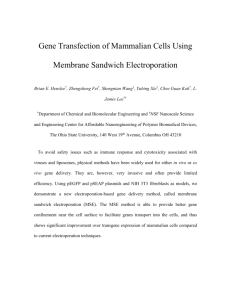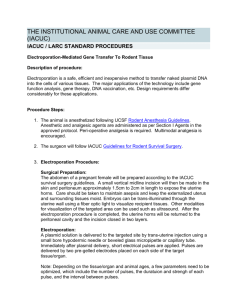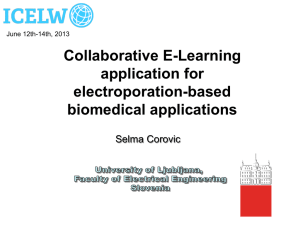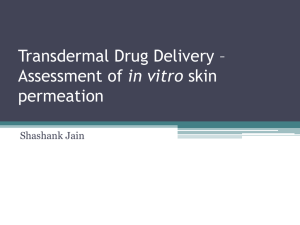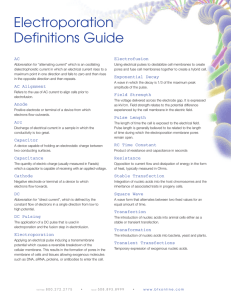controlled release Do high-voltage pulses cause changes in
advertisement
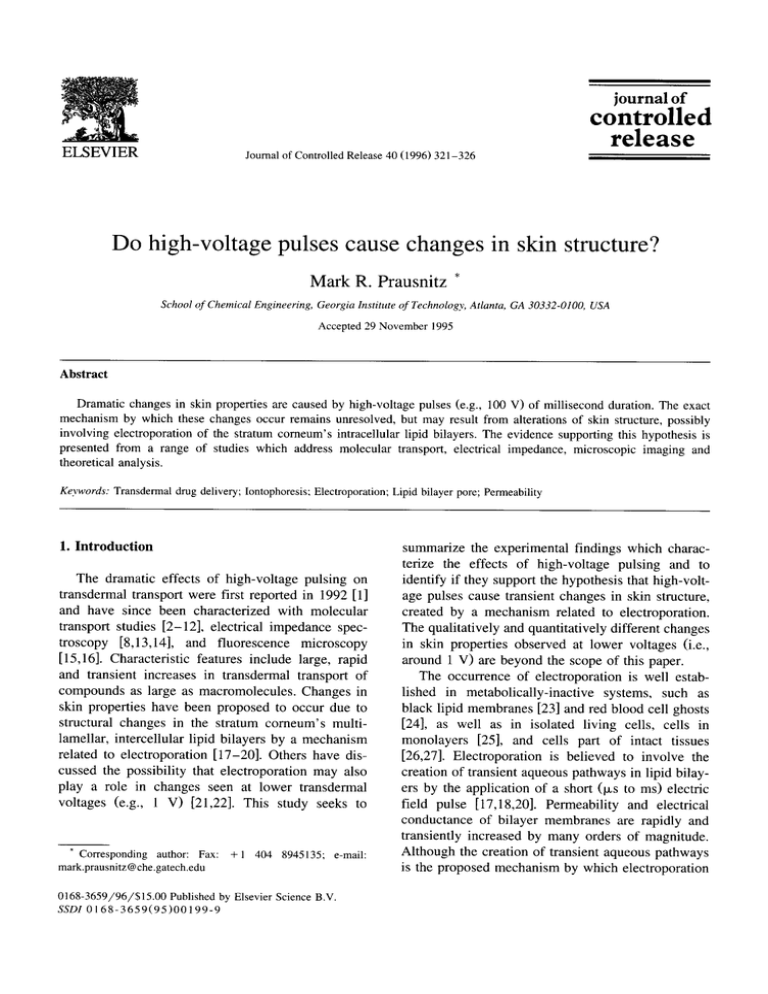
journal o f
controlled
release
ELSEVIER
Journal of Controlled Release 40 (1996) 321-326
Do high-voltage pulses cause changes in skin structure?
Mark R. Prausnitz *
School of Chemical Engineering, Georgia Institute of Technology, Atlanta, GA 30332-0100, USA
Accepted 29 November 1995
Abstract
Dramatic changes in skin properties are caused by high-voltage pulses (e.g., 100 V) of millisecond duration. The exact
mechanism by which these changes occur remains unresolved, but may result from alterations of skin structure, possibly
involving electroporation of the stratum corneum's intracellular lipid bilayers. The evidence supporting this hypothesis is
presented from a range of studies which address molecular transport, electrical impedance, microscopic imaging and
theoretical analysis.
Keywords: Transdermal drug delivery; Iontophoresis: Electroporation; Lipid bilayer pore; Permeability
1. Introduction
The dramatic effects of high-voltage pulsing on
transdermal transport were first reported in 1992 [1]
and have since been characterized with molecular
transport studies [2-12], electrical impedance spectroscopy [8,13,14], and fluorescence microscopy
[15,16]. Characteristic features include large, rapid
and transient increases in transdermal transport of
compounds as large as macromolecules. Changes in
skin properties have been proposed to occur due to
structural changes in the stratum corneum's multilamellar, intercellular lipid bilayers by a mechanism
related to electroporation [17-20]. Others have discussed the possibility that electroporation may also
play a role in changes seen at lower transdermal
voltages (e.g., 1 V) [21,22]. This study seeks to
* Corresponding author: Fax:
mark.prausnitz@che.gatech.edu
+1
404 8945135; e-mail:
0168-3659/96/$15.00 Published by Elsevier Science B.V.
SSD1 0 1 6 8 - 3 6 5 9 ( 9 5 ) 0 0 1 9 9 - 9
summarize the experimental findings which characterize the effects of high-voltage pulsing and to
identify if they support the hypothesis that high-voltage pulses cause transient changes in skin structure,
created by a mechanism related to electroporation.
The qualitatively and quantitatively different changes
in skin properties observed at lower voltages (i.e.,
around 1 V) are beyond the scope of this paper.
The occurrence of electroporation is well established in metabolically-inactive systems, such as
black lipid membranes [23] and red blood cell ghosts
[24], as well as in isolated living cells, cells in
monolayers [25], and cells part of intact tissues
[26,27]. Electroporation is believed to involve the
creation of transient aqueous pathways in lipid bilayers by the application of a short (Ixs to ms) electric
field pulse [17,18,20]. Permeability and electrical
conductance of bilayer membranes are rapidly and
transiently increased by many orders of magnitude.
Although the creation of transient aqueous pathways
is the proposed mechanism by which electroporation
322
M.R. Prausnitz, / Journal of Controlled Release 40 (1996) 321-326
occurs, the exact physical nature of any structural
changes remains unresolved [17-20].
In skin, direct evidence (i.e., by microscopy) for
structural changes due to high-voltage pulsing has
not been reported. However, this is not surprising if
changes in skin microstructure are similar to those
seen during electroporation of single lipid bilayer
membranes, where aqueous pathways are believed to
be small ( < 10 nm), sparse ( < 0 . 1 % of surface
area), and generally short-lived (l*s to s) [17,18,20],
making their capture by any form of microscopy
extremely difficult [28]. However, there is considerable indirect evidence which can give insight as to
whether high-voltage pulses cause changes in skin
structure. These results are summarized below; detailed descriptions of experimental methods can be
found in the original articles.
2. E v i d e n c e for skin structural changes
2.1. Dramatic increases in transdermal flux for forward-, ret,erse-, and alternating-polariS' pulses
Enhancement of transdermal transport at low voltage (e.g., < 1 V) can generally be explained by
electrophoresis a n d / o r electro-osmosis without
changes in skin structure [21,29,30]. Therefore, if
protocols having the same electrophoretic driving
force provide different degrees of enhancement, this
suggests that changes in skin properties occurred.
This difference has been seen during high-voltage
pulsing, where increases in transdermal transport up
to four orders of magnitude have been observed with
a number of different molecules ranging in molecular mass from a few hundred to a few thousand
Daltons [2-12] (Fig. 1). In contrast, when the same
time-averaged electrophoretic driving force is provided by continuous low-voltage electric fields, a
thousand-fold less enhancement is seen [2]. Using
alternating-polarity pulses, transport can be increased
up to three orders of magnitude (Fig. 1), while no
enhancement results from an equivalent low-voltage
ac current, which provides the same time-averaged
driving force for transport [9]. Finally, increases in
transport of two orders of magnitude have been seen
when the polarity is such that electrophoresis opposes transdermal transport (Fig. 1). These compar-
i E+2-
IE+I
::::L
1E+O-
T
E
T•
1El-
!
!
6
I
T
!°!
IE-2-
T
•
Y
[E3
0
100
2f~)
~00
4{'~)
5{)(t
transdermal voltage (V)
Fig. 1. Transdermal flux of calcein (623 Da, - 4 charge) across
human skin in vitro caused by: ( • ) forward-polarity pulsing (data
from reference [2], with permission), ( O ) alternating-polarity
pulsing (data from reference [9], with permission, and ( I ) reverse-polarity pulsing (data from reference [2], with permission).
Exponential-decay pulses ( ~ 1 ms time constant) were applied at
a rate of 12 pulses per min for 1 h. During forward-polarity
pulsing, the negative electrode was in the donor compartment and
the positive electrode was in the receptor compartment, such that
electrophoresis would transport calcein across the skin. During
alternating-polarity pulsing, the electrode polarity alternated with
each pulse such that the total time-integral of voltage over all
pulses was zero. During reverse-polarity pulsing, the positive
electrode was in the donor compartment and the negative electrode was in the receptor compartment, such that electrophoresis
would transport calcein away from the skin. Positive standard
deviation bars are shown.
isons suggest that electrophoresis alone cannot explain the large flux increases observed during highvoltage pulsing, which indicates that changes in skin
properties may have occurred.
2.2. Highly nonlinear dependence of flux on voltage
and pulse length
Transport by electrophoresis should be approximately directly proportional to the applied voltage if
the skin's barrier properties remain intact [21,29,30].
However, transdermal transport during high-voltage
pulsing exhibits a highly nonlinear dependence on
voltage, especially between approximately 50-100 V
[2,7] (Fig. 1). This suggests that significant changes
in skin barrier properties may have occurred. Theoretical predictions indicate that electroporation of
M.R. Prausnitz / Journal of Controlled Release 40 (1996) 321-326
stratum corneum lipid bilayers could occur at voltages in this range [31,32].
Consistent with transport by electrophoresis,
transdermal flux has been shown to be proportional
to pulse length for long, high-voltage pulses ( > 30
Ixs). However, short pulses (10 Ixs) cause fluxes
disproportionately low by two orders of magnitude
[9]. While this nonlinearity cannot be explained by
electrophoresis alone, it could be accounted for by
voltage-induced, time-dependent growth of transport
pathways across skin [9].
323
1E-2
1E-3-
i
" !"
360
4~0
!
1E-4-
!TI!
1E-5' _T
2.3. Enhancement of transport for compounds as
large as macromolecules
High-voltage pulsing has been shown to enhance
transport into or across skin for compounds ranging
in size from small ions (e.g., Na +, C1- [9,14]) to
moderate-sized molecules (e.g., calcein [2,7,9], sulforhodamine [8], metoprolol [6]) to macromolecules
(e.g., L H R H [4], heparin [10], oligonucleotides [12])
to latex microspheres of micron dimensions [16]. It is
likely that changes in skin structure would be required to transport large numbers of macromolecules
and microspheres.
2.4. Rapid and lasting changes in skin permeability
Skin electrical resistance has been shown to drop
three orders of magnitude on a time scale of microseconds or faster during high-voltage pulses
[9,14]. Flux measurements also show increased transdermal transport after only 2 - 4 pulses, each of millisecond duration [5]. Steady-state transport can be
achieved in a matter of minutes [5]. Such rapid
changes in skin permeability have not been reported
with other methods of enhancement, suggesting that
transport may occur by a different mechanism. These
changes are consistent with known features of single-bilayer electroporation [17-20].
Long-lived changes in skin permeability suggest
that skin structure may have been altered. Lasting
effects have been seen after high-voltage pulsing,
where increased transdermal flux generally persists
for minutes to hours, but is often reversible [5-7].
Under some conditions, passive transdermal transport can remain elevated for over 24 h [2,10]. Related studies show that a single high-voltage pulse
,~,
260
5®
transdermal voltage (V)
Fig. 2. Transport number for calcein transport across human skin
in vitro during (m) exponential-decay pulses (data from references [2,9], with permission) and ( • ) square-wave pulses (data
from reference [9], with permission). For each data point, pulses
of a constant duration between 30 p,s- - 1 ms were applied for 1 h
at a constant rate between 10 1-104 pulses per min. Positive
standard deviation bars are shown.
significantly increases skin permeability during subsequent iontophoresis [4]. These examples of lasting,
but not permanent, increases in skin permeability
suggest that changes in skin structure occurred, and
that they are at least partially reversible.
2.5. Transport numbers give evidence for enlarged
transport pathways
Transport number is a measure of the efficiency
with which current transports a given compound
[29]. While a low transport number indicates hindered transport, larger transport numbers indicate
less hindrance. During high-voltage pulsing, transport number has been shown to increase over two
orders of magnitude with increasing voltage (Fig. 2).
This suggests that larger transport pathways (which
provide less hindrance to transport) exist at larger
voltages, although other interpretations are possible.
In contrast, transport number was not found to depend on pulse rate, length, energy, waveform, or
time-averaged current [9]. This suggests that transport pathway size is controlled by a voltage-dependent mechanism. Moreover, in a direct comparison
of high-voltage and low-voltage exposures with the
324
M.R. Prausnitz / Journal of Controlled Release 40 (1996) 321 326
same time-averaged current, transport of a macromolecule (heparin) was determined to be an order of
magnitude less hindered during high-voltage pulsing
than during low-voltage iontophoresis [10]. This indicates that high-voltage pulses can create or enlarge
pathways large enough to pass macromolecules.
2.6. Microscopy shows extensiL, e transport through
the bulk o f stratum corneum
Fluorescence microscopy and electrical studies
indicate that molecular transport during high-voltage
pulsing occurs through the bulk of the stratum
corneum at localized sites through intercellular and
transcellular pathways (Fig. 3) [15,16]. Sites of fluorescence staining were shown to correspond to sites
of molecular and current transport [15]. Transport
through skin appendages does not appear to be significant [15,16]. In these studies, pathways for ion
transport have been estimated to occupy up to 0.1%
of skin surface area [9,15]. Similarly, electroporation
of single bilayers is also believed to porate up to
0.1% of membrane area [33]. In contrast, transport
pathways at low voltages ( < 1 V) occupy only up to
an estimated 0.001% of skin area [9] and are believed to correspond to skin appendages [34]. These
microscopy experiments suggest that transport during high-voltage pulsing utilizes an area for transport
two orders of magnitude greater than low-voltage
protocols, presumably due to alterations in skin
structure.
2.7. Dramatic reduction and recovery o f skin resistance
Electrical measurements can be used to complement results from molecular transport studies. During application of a high-voltage pulse, skin resistance has been shown to drop three orders of magnitude within 2 p~s [9,14]. Electroporation of single
Fig. 3. Micrograph of human stratum corneum showing fluorescence of calcein transported by high-voltage pulsing in vitro. Sites of
fluorescence can be interpreted as sites of transdermal calcein transport [15]. Scale bar equals 200 ixm. Data are from reference [15], with
permission.
M.R. Prausnitz/ Journal of Controlled Release 40 (1996) 321-326
bilayers is also known to occur on a time scale of
microseconds or faster [17-20]. Such dramatic and
rapid changes in resistance suggest that significant
structural changes occurred. Within milliseconds after a pulse, skin resistance has been observed to
recover by an order of magnitude [8,14]. Then, over
a time scale of minutes, skin resistance recovers
further, exhibiting either complete or partial reversibility. Again, the time scales and degrees of
recovery are characteristic of known properties of
single-bilayer electroporation [17-20].
2.8. Reversible increases in skin capacitance
Measurements made immediately after high-voltage pulsing have shown up to six-fold increases in
skin capacitance which later recover to pre-pulse
values [13,14]. Increased capacitance may indicate
changes in skin lipids [35], since skin's capacitance
is generally attributed to stratum corneum lipid bilayers [36,37]. In contrast, low-voltage electric fields
have been shown to have no effect or cause much
smaller changes in skin capacitance [37-39].
2.9. Models f o r electrically-enhanced transdermal
transport
Models for transport caused by low-voltage electric fields have been developed [21,30,40] based
largely on the N e r n s t - P l a n c k equation [29]. These
models can account for diffusion, convection, electro-osmosis, and voltage-induced changes in skin
structure, but have not been applied to high-voltage
pulsing. Another approach [39] applied at low currents, shows that current-induced skin resistance
changes might be explained by an electro-osmotic
mechanism which does not involve skin structural
changes. However, characteristics of high-voltage
pulsing, such as increased transport number, capacitance changes, and increased transport in the direction opposite to electro-osmotic flow, cannot be explained by electro-osmosis alone.
Theoretical analysis of skin electroporation has
predicted that the multilamellar lipid bilayers of human stratum corneum could electroporate at voltages
on the order of 100 V [31,32]. The resulting predictions of transdermal transport through skin containing structural changes consistent with known features of electroporation are in good agreement with
experimental data [31,32].
theoretical basis exists for
and establishes that these
explaining many of the
high-voltage pulsing.
325
This both shows that a
changes in skin structure
changes are capable of
characteristic effects of
3. Conclusions
Experiments show that high-voltage pulses have
dramatic effects on the skin. A variety of mechanisms could be proposed to explain these results.
However, a useful model should be capable of explaining many or all of the characteristic features
observed experimentally and summarized above.
Transient changes in skin structure, created by a
mechanism related to electroporation, generally satisfies this requirement and is therefore proposed as a
promising hypothesis.
Acknowledgements
Thanks to V. G. Bose, R. Langer, S. Mitragotri,
U. Pliquett, and J. C. Weaver for helpful discussions.
This work was supported in part by the Whitaker
Foundation for Biomedical Engineering.
References
[1] M.R. Prausnitz, V.G. Bose, R. Langer and J.C. Weaver,
Transdermal drug delivery by electroporation, Proc. Int.
Symp. Control. Rel. Bioact. Mater. 19 (1992) 232 233.
[2] M.R. Prausnitz, V.G. Bose, R. Langer and J.C. Weaver,
Electroporation of mammalian skin: A mechanism to enhance transdermal drug delivery, Proc. Natl. Acad. Sci. USA
90 (1993) 10504-10508.
[3] M.R. Prausnitz, D.S. Seddick, A.A. Kon, V.G. Bose, S.
Frankenburg, S.N. Klaus, R. Langer and J.C. Weaver, Methods for in vivo tissue electroporation using surface electrodes, Drug Delivery 1 (1993) 125-131.
[4] D. Bommannan, J. Tamada, L. Leung and R.O. Potts, Effect
of eleetroporation on transdermal iontophoretic delivery of
luteinizing hormone releasing hormone (LHRH) in vitro,
Pharm. Res. 11 (1994) 1809-1814.
[5] M.R. Prausnitz, U. Pliquett, R. Langer and J.C. Weaver,
Rapid temporal control of transdermal drug delivery by
electroporation, Pharm. Res. 11 (1994) 1834-1837.
[6] R. Vanbever, N. Lecouturier and V. Prrat, Transdermal
delivery of metoprolol by electroporation, Pharm. Res. 11
(1994) 1657-1662.
326
M.R. Prausnitz / Journal of Controlled Release 40 (1996) 321-326
[7] U. Pliquett and J.C. Weaver, Transport of a charged molecule
across the human epidermis due to electroporation, J. Control. Rel. in press.
[8] U. Pliquett and J.C. Weaver, Electroporation of human skin:
Simultaneous measurement of changes in the transport of
two fluorescent molecules and in the passive electrical properties, Bioelectrochem. Bioenerget. 39 (1996) 1-12.
[9] M.R. Prausnitz, C.S. Lee, C.H. Liu, J.C. Pang, T.-P. Singh,
R. Langer and J.C. Weaver, Transdermal transport efficiency
during skin electroporation and iontophoresis, J. Control.
Rel. 38 (1996) 205-217.
[10] M.R. Prausnitz, E.R. Edelman, J.A. Gimm, R. Langer and
J.C. Weaver, Transdermal delivery of heparin by skin electroporation, Bio/Technology 20 (1995) 1205-1209.
[11] R. Vanbever and V. Preat, Factors affecting transdermal
delivery of metoprolol by electroporation, Bioelectrochem.
Bioenerget. 38 (1995) 286-292.
[12] T.E. Zewert, W.F. Pliquett, R. Langer and J.C. Weaver,
Transdermal transport of DNA antisense oligonucleotides by
electroporation, Biochem. Biophys. Res. Commun. 212
(1995) 286-291.
[13] V.G. Bose, Electrical Characterization of Electroporation of
Human Stratum Corneum, MSc Thesis, Massachusetts Institute of Technology, 1994.
[14] U. Pliquett, R. Langer and J. C. Weaver, Changes in the
passive electrical properties of human stratum corneum due
to electroporation, Biochim. Biophys. Acta 1239 (1995) 111121.
[15] U. Pliquett, T.E. Zewart, T. Chen, R. Langer and J.C.
Weaver, Imaging of fluorescent molecule and small ion
transport through human stratum corneum during high voltage pulsing: localized transport regions are involved., Biophys. Chem. 58 (1996) 185-204.
[16] M.R. Prausnitz, J.A. Gimm, R.H. Guy, R. Langer, J.C.
Weaver and C. Cullander, Imaging regions of transport across
human stratum corneum during high-voltage and low-voltage
exposures, J. Pharm. Sci., in press.
[17] E. Neumann, A.E. Sowers and C.A. Jordan (eds), Electroporation and Electrofusion in Cell Biology, Plenum Press,
New York, 1989.
[18] D.C. Chang, B.M. Chassy, J.A. Saunders and A.E. Sowers
(eds), Guide to Electroporation and Electrofusion, Academic
Press, New York, 1992.
[19] S. Orlowski and L.M. Mir, Cell electropermeabilization: A
new tool for biochemical and pharmacological studies,
Biochim. Biophys. Acta 1154 (1993) 51-63.
[20] J.C. Weaver, Electroporation: A general phenomenon for
manipulating cells and tissues, J. Cell. Biochem. 51 (1993)
426-435.
[21] G.B. Kasting, Theoretical models for iontophoretic delivery,
Adv. Drug Deliv. Rev. 9 (1992) 177-199.
[22] H. Inada, A.-H. Ghanem and W.I. Higuchi. Studies on the
effects of applied voltage and duration on human epidermal
membrane alteration/recovery and the resultant effects upon
iontophoresis, Pharm. Res. 11 (1994) 687-697.
[23] L.V. Chernomordik, S.I. Sukharev, l.G. Abidor and Y.A.
Chizmadzhev, The study of the BLM reversible electrical
[24]
[25]
[26]
[27]
[28]
[29]
[30]
[31]
[32]
[33]
[34]
[35]
[36]
[37]
[38]
[39]
[40]
breakdown mechanism in the presence of UO~-, Bioelectrochem. Bioenerget. 9 (1982) 149-155.
A.E. Sowers and M.R. Lieber, Electropore diameters, lifetimes, numbers, and locations in individual erythrocyte
ghosts, FEBS Lett. 205 (1986) 179-184.
S. Kwee, H.V. Nielsen and J.E. Celis, Electropermeabilization of human cultured c~lls grown in monolayers, Bioelectrochem. Bioenerget. 23 (1990) 65-80.
J. Belehradek, S. Orlowski, L.H. Ramirez, G. Pron, B.
Poddevin and L.M. Mir, Electropermeabilization of cells in
tissues assessed by the qualitative and quantitative electroloading of bleomycin, Biochim. Biophys. Acta 1190 (1994)
155-163.
S.B. Dev and G.A. Hofmann, Electrochemotherapy-a novel
method of cancer treatment, Cancer Treat. Rev. 20 (19941)
105-115.
D.C. Chang and T.S. Reese, Changes in membrane structure
induced by electroporation as revealed by rapid-freezing
electron microscopy, Biophys. J. 58 (1990) 1-12.
J.O. Bockris and A.K.N. Reddy, Modern Electrochemistry,
Plenum Press, New York, 1970.
V. Srinivasan, W.I. Higuchi, S.M. Sims, A.H. Gbanem and
C.R. Behl, Transdermal iontophoretic drug delivery: mechanistic analysis and application to polypeptide delivery, J.
Pharm. Sci. 78 (1989) 370 375.
Y.A. Chizmadzhev, V.G. Zarnytsin, J.C. Weaver and R.O.
Potts, Mechanism of electroinduced ionic species transport
through a multilamellar lipid system, Biophys. J. 68 (1995)
749-765.
D.A. Edwards, M.R. Prausnitz, R. Langer and J.C. Weaver,
Analysis of enhanced transdermal transport by skin electroporation, J. Control. Rel. 34 (1995) 211-221.
S.A. Freeman, M.A. Wang and J.C. Weaver, Theory of
electroporation of planar membranes: predictions of the aqueous area, change in capacitance and pore-pore separation,
Biopbys. J. 67 (1994) 42-56.
C. Cullander, What are the pathways of iontophoretic current
flow through mammalian skin?, Adv. Drug Deliv. Rev. 9
(1992) 119 135.
R.O. Potts, R.H. Guy and M. L. Francoeur, Routes of ionic
permeability through mammalian skin, Solid State Ionics
53-56 (1992) 165-169.
J.D. DeNuzzio and B. Berner, Electrochemical and iontophoretic studies of human skin, J. Control. Rel. 11 (1990)
105-112.
S.Y. Oh, L. Leung, D. Bommannan, R.H. Guy and R.O.
Potts, Effect of current, ionic strength and temperature on the
electrical properties of skin, J. Control. Ret. 27 (1993) 115125.
T. Yamamoto and Y. Yamamoto, Non-linear electrical properties of skin in the low frequency range, Med. Biol. Eng.
Comput. 19 (1981) 302-310.
S.M. Dinh, C.-W. Luo and B. Berner, Upper and lower limits
of human skin electrical resistance in iontopboresis, AIChE
J. 39 (1993) 2011-2018.
M.J. Pikal, The role of electro-osmotic flow in transdermal
iontophoresis, Adv. Drug Deliv. Rev. 9 (1992) 201-237.
